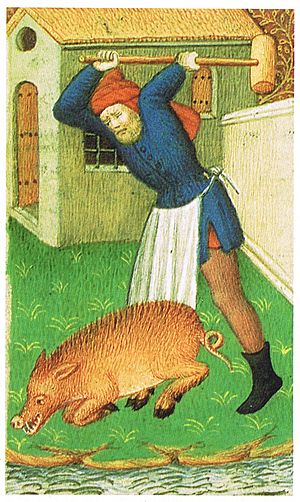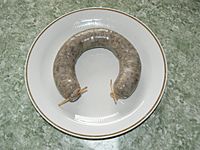Pig slaughter facts for kids
Pig slaughter is when pigs are prepared for their meat. It's an important activity for getting food, and in some parts of Europe and Asia, it's also a special tradition or celebration.
Contents
Why Pigs Are Prepared in Autumn
Traditionally, pigs are prepared in the autumn and early winter. There are good reasons for this timing:
- It gets cold enough for the meat to stay fresh naturally. This is important because there's a lot of meat!
- It's not too cold to work outside comfortably.
- The meat is ready in time for Christmas celebrations.
In the past, this was often the only time families could get a lot of meat. Today, most families can buy meat easily from shops. So, preparing pigs at home has become more of a tradition than something people have to do.
Getting ready for this event takes a lot of planning. People need big containers, lots of hot water, pots, sharp knives, and sometimes special tools for making sausages.
Historically, learning how to prepare pigs was a skill passed down through families. Nowadays, a professional butcher usually does the first part. After that, family members and friends help cut and prepare the meat. This process often includes local rituals and customs.
How Pig Parts Are Used
Almost every part of the pig is used to make different kinds of food:
- The back legs are salted and pressed to make delicious ham.
- Meat from the ribs is salted and smoked to create bacon. Salt and pepper are rubbed all over the meat to help preserve it and add flavor.
- Most of the other meat is ground up to make various sausages. These are often put into the pig's own cleaned intestines.
- The fat is cut into small pieces. Some of it is fried to make crispy cracklings.
- Lard is made by heating the fat until it turns into a liquid grease. When it cools, it becomes solid and can be stored for cooking.
- In some countries, fat is salted as it is, to make foods like salo or lardo.
- The intestines are carefully cleaned, cut, and fried to make chitlins.
- Other parts, like the head and skin, are used to make things like headcheese or jelly.
A smoke house is very important for keeping hams, bacon, and other meats fresh for a long time. The meat hangs inside while fragrant wood, like hickory or cherry, slowly burns below. This smoking process adds flavor and color, and helps dry and preserve the meat.
Traditions in Different Countries
Croatia and Nearby Countries
In Croatia and nearby countries like Bosnia and Herzegovina, Slovenia, and Serbia, the traditional pig preparation is called "koline" or "svinjokolje." It's a widespread practice for families in the countryside, usually in late autumn.
In the past, a national holiday in Yugoslavia often meant people did their pig preparation around November 29th. In the Croatian region of Dalmatia, it's often done between Christmas and New Year's Eve.
The whole process can take up to three days. Families often prepare more than one pig to stock up for winter. Relatives and friends often visit to help out. Most of the work, like cutting and grinding meat, is done by hand.
Many delicious foods come from this tradition, including:
- Traditional ham (šunka)
- Bacon (slanina)
- Sausages (kobasica), like blood sausage (krvavica) and kulen
- Cracklings (čvarci)
- hladetina (a type of meat jelly)
People often drink rakija (a type of fruit brandy) or wine while they work. The pig's liver is usually roasted and eaten on the same day.
Traditionally, men and women had different roles. Men usually did the actual preparation and most of the meat cutting. Women often cooked for everyone, kept things clean, and prepared the pig's intestines for sausages.
Veterinarians have rules for keeping things clean and safe during this process. Everyone involved should be healthy and wear clean clothes. Tools must be sharp, clean, and disinfected. The area where the work is done should be easy to clean.
Czech Republic
In the Czech Republic, traditional pig preparation, called zabijačka, is a special winter event. It usually happens when it's cold, which helps keep the meat fresh. People spend several days getting ready, and there are often special ceremonies.
During the zabijačka, traditional dishes are made, such as:
After the main work, young men from the village might visit neighbors and relatives, bringing gifts of fresh meat and soup. The event ends with a celebration called a karmina at the house where the pig was prepared. Guests, sometimes wearing masks, join in the feasting and drinking.
Even today (as of 2011), traditional zabijačka events happen in public at Mardi Gras celebrations in many Czech towns.
However, preparing pigs at home is becoming less common. During the time of communism, it was cheaper for people to raise and prepare pigs at home. Many villagers worked on collective farms, making it easier to get food for their pigs. Now, it's less common and also has to follow rules from the European Union.
The famous Czech painter Josef Lada often showed traditional pig preparation in his paintings. The play Prase (The Pig, 1987) by Václav Havel is about trying to buy a pig for a zabijačka.
Slovakia
In Slovakia, pig preparation (called zabíjačka or zakáľačka) has been a key part of winter traditions since early medieval times. It was an important social event in villages, bringing families together.
According to experts, the traditional time for pig preparation usually started around December 21st, the feast day of St. Thomas. People believed that meat from a pig prepared on this day would last longer. Another traditional period began around Mardi Gras.
In the past, there were special customs linked to the pig preparation. For example, after the work was done, girls in the household would collect the bones and scatter them in the yard. They believed that if a dog picked up the first bone, the girl who threw it would be the first to get married.
See also
 In Spanish: Matanza del cerdo para niños
In Spanish: Matanza del cerdo para niños



